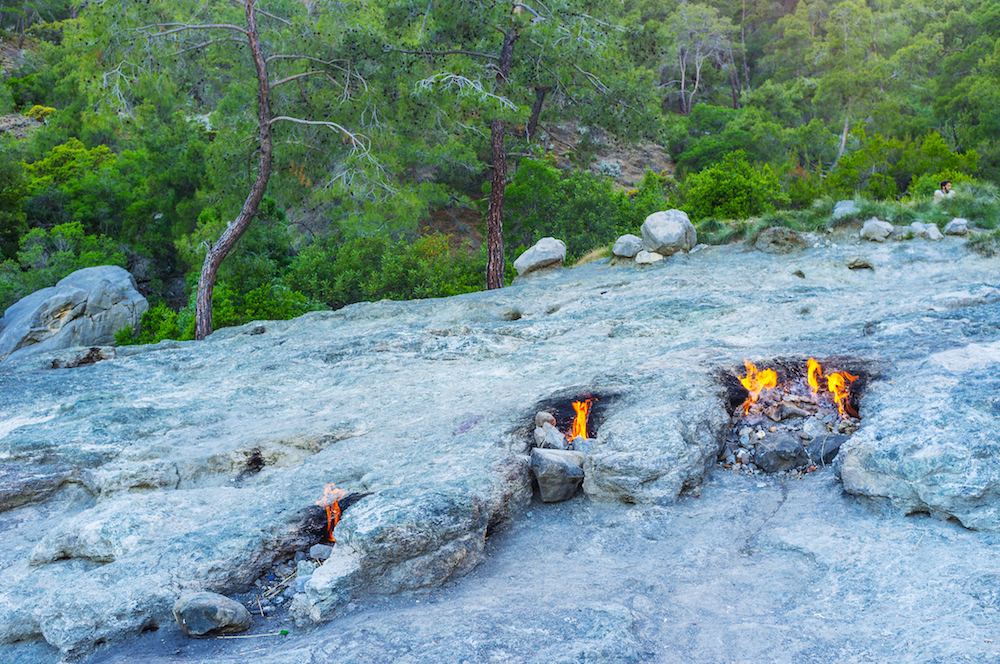Fire-Breathing Mountain Fueled by Mysterious Deep-Earth Methane Production

Nine out of 10 scientists agree, mountains should not breathe fire. Despite this, a mountain in southern Turkey has been spewing flames steadily for at least 2,000 years.
There be no dragons or magic to blame for the fire belching forth from the so-called Chimaera seep (also known as the Flames of Chimaera) — but, according to an article published in The New York Times, there may be a just-as-baffling geologic phenomenon fueling the flames.
According to a study in the March 2019 issue of the journal Applied Geochemistry, the Flames of Chimaera are fueled by an underground seep of methane (CH4) — but not the garden-variety sort that's produced when organic matter decays underground, mixes with hydrogen and makes Arctic lakes fart fire. [50 Interesting Facts About Earth]
Rather, the gas fueling Turkey's eternal flame is known as abiotic methane, meaning it is produced spontaneously through chemical reactions between rocks and water deep underground — no decaying plant or animal matter necessary.
In the past decade, scientists working at the Deep Carbon Observatory, an international group studying Earth's deep biosphere and the many millions of undiscovered microbial species living there, have identified hundreds of abiotic methane deposits on land and sea around the world.
"It's not a rare phenomenon," Giuseppe Etiope, a member of the group and lead author of the recent study, told Times reporter JoAnna Klein.
It is, however, a somewhat mysterious one. In the new study, Etiope lists the various hypotheses that have been offered to explain how methane might emerge from the deep Earth without any organic carbon involved. The explanations point to everything from cooling magma to steamy, deep-Earth minerals to primordial meteorites that delivered methane to Earth during the planet's formation. But the most widely cited theory involves a process called serpentinization.
Get the world’s most fascinating discoveries delivered straight to your inbox.
This process occurs when water seeps through certain kinds of minerals in Earth's mantle, causing a metamorphic reaction that results in the release of hydrogen gas (H2). This molecular hydrogen may subsequently react with carbon gas (CO or CO2) in the deep Earth, resulting in the creation of methane. In the case of the Flames of Chimaera, Klein wrote, carbon-dioxide-rich limestone reacts with hydrogen-heavy serpentinized rocks that were bathed in rainwater. Hence, two millennia of mountainside fire farts.
Flaming mountains aside, learning to better identify the differences between abiotic methane and methane produced from organic material could aid scientists in the search for life on other worlds, Klein wrote. For example, methane found in the atmosphere of Mars might be a sign of microbial life — or, it could be a result of serpentinization below the Red Planet's surface. Right now, there's no way to tell the difference from afar. Confirming life on Mars could hinge on us knowing more about the gas on Earth.
- The Biggest Mysteries on Earth
- 10 Biggest Historical Mysteries That Will Probably Never Be Solved
- 25 Strangest Sights on Google Earth
Originally published on Live Science.

Brandon is the space / physics editor at Live Science. With more than 20 years of editorial experience, his writing has appeared in The Washington Post, Reader's Digest, CBS.com, the Richard Dawkins Foundation website and other outlets. He holds a bachelor's degree in creative writing from the University of Arizona, with minors in journalism and media arts. His interests include black holes, asteroids and comets, and the search for extraterrestrial life.


